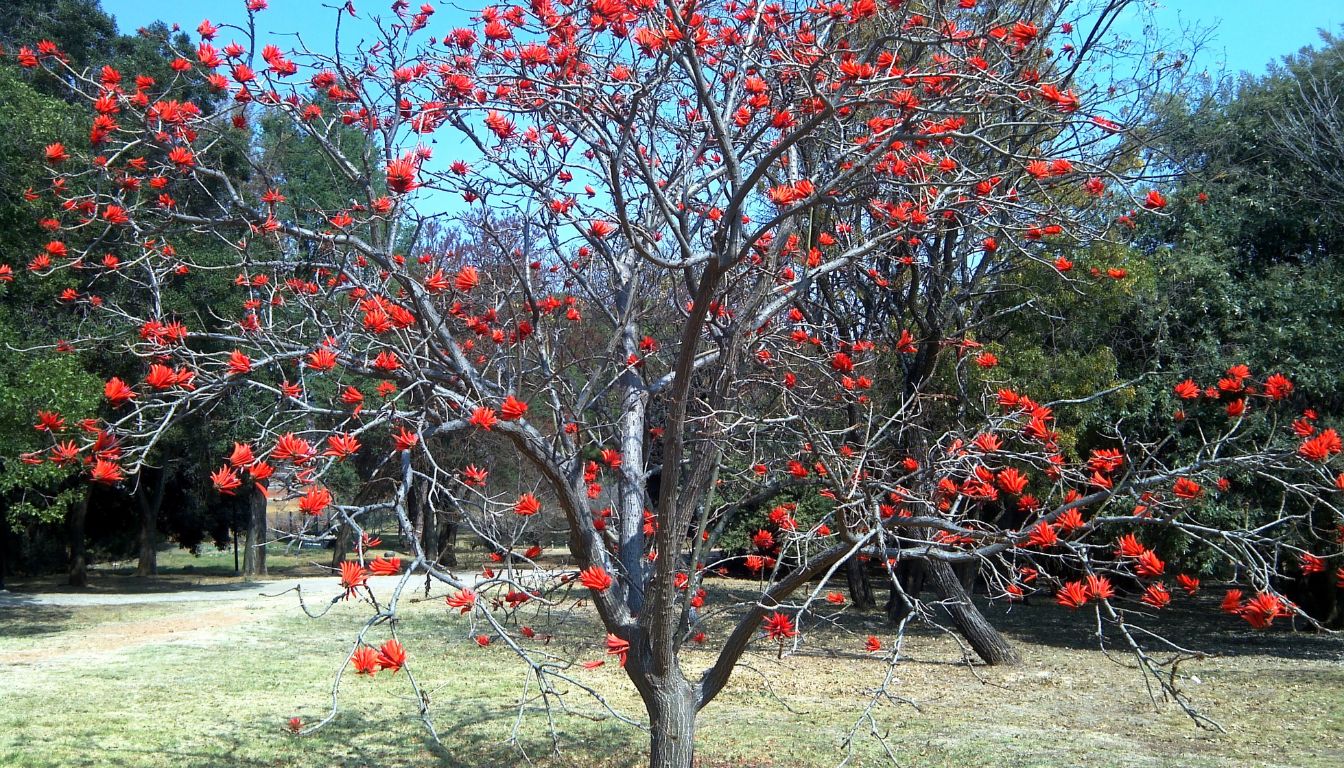If you’re looking to add a splash of color and unique charm to your garden, the coral tree plant might just be the perfect choice. With its striking red blossoms and distinctive structure, this eye-catching plant transforms any landscape into a vibrant oasis. Not only does it enhance your outdoor space, but it also attracts local wildlife, making your garden a lively ecosystem.
Coral Tree Plant Overview
The coral tree plant adds eye-catching beauty to any garden. With its bright red blossoms, it captures attention and creates a lively atmosphere.
Description and Characteristics – Transform Your Garden with the Vibrant Coral Tree Plant
The coral tree, also known as Erythrina, boasts unique features. Its stunning flowers emerge in clusters, drawing bees and hummingbirds. The tree can reach heights of 30 feet and offers a robust structure with thorny branches. Its leaves are large and fern-like, providing ample shade. The vibrant colors make it a popular choice for landscaped areas. In addition, the coral tree often serves as a focal point in gardens, leaving visitors in awe of its beauty.
Native Habitat and Distribution
Coral trees thrive in tropical and subtropical climates. They’re native to regions like Central and South America, as well as parts of Africa. These trees grow well in well-drained soils and do not require excessive water. In the United States, they mainly flourish in areas like Florida and southern California. During the right season, their vivid flowers become a delightful sight, celebrating the beauty of nature.
Growth and Care Requirements
The coral tree plant thrives with specific care and conditions. Understanding its needs helps maintain vibrant blooms and healthy growth.
Soil and Water Needs – Transform Your Garden with the Vibrant Coral Tree Plant
Coral trees prefer well-drained soils. Sandy or loamy soils work best, allowing water to flow freely. Overwatering can cause root rot, so I water lightly and only when the soil feels dry. A balanced moisture level keeps the plant healthy. It’s always a good idea to check the soil.
Sunlight and Temperature Preferences
Coral trees bask in full sunlight. They love soaking up those rays for at least six hours daily. This plant flourishes in warm temperatures, enjoying ideal conditions between 65 and 85 degrees Fahrenheit. If temperatures drop below 50 degrees, it may struggle. I find that keeping it cozy results in more blooms and happier foliage.
Benefits of the Coral Tree Plant

The coral tree plant offers many advantages for gardens and the environment. Its vibrant blossoms and unique structure make it a valuable addition to any landscape.
Aesthetic Value in Landscaping – Transform Your Garden with the Vibrant Coral Tree Plant
Coral trees bring instant charm to outdoor spaces. Their striking red flowers pop against green foliage, creating an eye-catching display. I often find that these trees serve as natural focal points in gardens. With a height of up to 30 feet, they provide vertical interest and can complement various plants and features. Their thorny branches add an intriguing texture, making the landscape more engaging. Each season, the clusters of flowers attract butterflies and birds, adding lively movement and color.
Environmental Contributions
Beyond aesthetics, coral trees support local ecosystems. They play a vital role in attracting pollinators like bees and hummingbirds. This helps maintain a balanced environment by contributing to healthy plant growth. Furthermore, these trees help improve soil quality. Their leaves, when they fall, decompose and enrich the ground below. Coral trees also create shade, which can lower temperatures in surrounding areas during hot days. This leads to more comfortable outdoor spaces for people and wildlife alike.
Potential Issues and Challenges
Coral trees, while stunning, come with a few challenges that need attention. I want to share some common problems and considerations for anyone interested in keeping this colorful beauty in their garden.
Pests and Diseases – Transform Your Garden with the Vibrant Coral Tree Plant
Coral trees can attract pests like aphids and scale insects. These creatures might enjoy the sap from the leaves, leaving your tree looking less than healthy. Regular inspections help spot these pests early. Consider using insecticidal soap or neem oil for an eco-friendly solution. Fungal infections can also occur, especially in humid conditions. Keeping the foliage dry and providing good air circulation helps prevent these problems. After all, a happy tree is a healthy tree!
Invasive Nature Concerns
As beautiful as they are, coral trees can become invasive in certain regions. Their rapid growth can overtake local plants, leading to a less diverse ecosystem. In Florida, for example, they’ve outgrown some native species. If the tree’s roots spread too wide, they might disrupt nearby gardens or yards. I must monitor how my coral tree behaves in the landscape and consider planting it in a controlled space. I love its beauty, but I also want to keep my garden and surrounding ecosystems thriving.
Before You Go – Transform Your Garden with the Vibrant Coral Tree Plant

The coral tree plant truly stands out as a stunning addition to any garden. Its vibrant red blossoms and unique structure not only enhance visual appeal but also support local wildlife. By creating a lively ecosystem, the coral tree invites pollinators like bees and hummingbirds, making my garden a thriving habitat.
While it requires specific care to flourish, the rewards are well worth the effort. I’ve found that with the right conditions, this tree can transform a landscape into a colorful paradise. Just remember to monitor its growth and manage any potential pests to ensure it remains a beneficial part of your garden. Embracing the coral tree means celebrating nature’s beauty while contributing to a healthier environment.
Don’t forget to add theherbprof.com homepage to your favourites so you don’t miss out on future articles.
References – Transform Your Garden with the Vibrant Coral Tree Plant
Little Herb Encyclopedia, by Jack Ritchason; N.D., Woodland Publishing Incorporated, 1995
The Ultimate Healing System, Course Manual, Copyright 1985, Don Lepore
Planetary Herbology, Michael Tierra, C.A., N.D., Lotus Press, 1988
Handbook of Medicinal Herbs, by James A. Duke, Pub. CRP Second Edition 2007
The Complete Medicinal Herbal, by Penelope Ody, Published by Dorling Kindersley
Check the Following Article
Grow Alfalfa Hay: Essential Tips to Boost Farm Productivity
Health Benefits of Medicinal Ghee in Everyday Cooking
10 Essential DIY Gardening Tools You Can Make at Home
Armenian Plums: Sweet, Healthy, and Versatile Delights
Frequently Asked Questions – Transform Your Garden with the Vibrant Coral Tree Plant
What is the coral tree plant?
The coral tree, or Erythrina, is a striking plant known for its vibrant red blossoms and unique structure. It can grow up to 30 feet tall and is native to tropical and subtropical regions, particularly in Central and South America and parts of Africa.
How do I care for a coral tree?
Coral trees thrive in full sunlight, requiring at least six hours of direct sun daily. They prefer well-drained sandy or loamy soils and should be watered lightly to prevent root rot. Keeping temperatures between 65 and 85 degrees Fahrenheit is essential for optimal growth.
What wildlife does the coral tree attract?
The coral tree attracts pollinators such as bees and hummingbirds due to its striking flowers. This contributes to a lively garden ecosystem, supporting local wildlife and promoting healthy plant growth.
Can coral trees become invasive?
Yes, coral trees can become invasive, particularly in regions like Florida. Their rapid growth may outcompete native species, so monitoring their growth and controlling planting spaces is important for maintaining a balanced garden ecosystem.
What are common pests of coral trees?
Common pests include aphids and scale insects, which can harm the health of the coral tree. Regular inspections and eco-friendly treatments, such as insecticidal soap or neem oil, are recommended for pest management.

